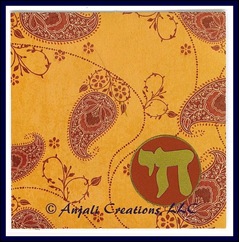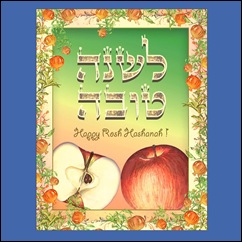This is the first of many holiday articles that you’ll find here at the EtsyChai blog, featuring some of our members along with their special and unique shop items.
Do you have a special Jewish holiday tradition or recipe you’d like to share with us? Leave a comment or email tamdoll(at)comcast[dot]net and don’t forget to subscribe to updates to make sure you catch the next article! - Tammy

The Jewish High Holiday season begins in the Hebrew month of Elul (August 22). It is a time to review one's deeds and spiritual progress over the past year and prepare for the upcoming "Days of Awe" of Rosh HaShanah and Yom Kippur. As the month of Divine Mercy and Forgiveness, it is an opportune time for teshuvah ("return" to G-d), prayer, charity, renewal and increased love for a fellow Jews and human beings in the quest for self-improvement and coming closer to G-d. Before we can improve our relationship with G-d, we must first repent to our friends and families.


Preparations: In the home, fall cleaning is done and recipes are gathered. Shana Tovah (Happy New Year) greeting cards are sent. Studies of Torah, Cantors are reviewing High Holiday melodies and synagogues are mailing out high holidays tickets and getting ready to change the Torah covers and other accessories to white. White is the symbol of purity and prayer leaders wear a kittel, or a white garment to lead services, expressing the intention to clean their personal slate of “sins” and plead for G-d’s acceptance of the community into the Book of Life.
Rosh Hashanah means "Head of the Year" and is observed for two days and begins on Fri., Sept. 18 at sundown. It is the anniversary of the creation of Adam and Eve, the first man and woman, and their first actions toward the realization of mankind's role in G-d's world. Rosh Hashanah emphasizes the special relationship between G-d and humanity and we proclaim G-d as King.
 The central observance of Rosh Hashanah is the sounding of the shofar, the ram's horn, which represents the trumpet blast of a people's coronation of their king. The cry of the shofar is also a call to repentance; for Rosh Hashanah is also the anniversary of man's first sin and his repentance thereof, and serves as the first of the "Ten Days of Repentance" which culminate in Yom Kippur, the Day of Atonement. Altogether, the shofar is sounded 100 times in the course of the Rosh Hashanah service.
The central observance of Rosh Hashanah is the sounding of the shofar, the ram's horn, which represents the trumpet blast of a people's coronation of their king. The cry of the shofar is also a call to repentance; for Rosh Hashanah is also the anniversary of man's first sin and his repentance thereof, and serves as the first of the "Ten Days of Repentance" which culminate in Yom Kippur, the Day of Atonement. Altogether, the shofar is sounded 100 times in the course of the Rosh Hashanah service.
Additional Rosh Hashanah observances include: a) Eating a piece of apple dipped in honey to symbolize our desire for a sweet year, and other special foods symbolic of the new year's blessings, b) Blessing one another with the words “Leshanah tovah tikateiv veteichateim, May you be inscribed and sealed for a good year " and c) Tashlich, a special prayer said near a body of water (an ocean, river, pond, etc.) in evocation of the verse, "And you shall cast their sins into the depths of the sea."
Author: Linda Blatchford, http://lindab142.etsy.com Source: Chabad.org
“My family's minhag (custom) is to purchase something new to wear to shul for the High Holidays. I would get a new dress or blouse and skirt, but now I make a new piece of jewelry or a kippah.” - Linda


1 comment:
Hi Tammy –
Please can you add my blog to the sidebar:
http://lisa-handmadeinisrael.blogspot.com/
I am a newbie and intend to write a little introduction about myself over the weekend.
Thanks a lot,
Lisa
Handmade in Israel
Post a Comment